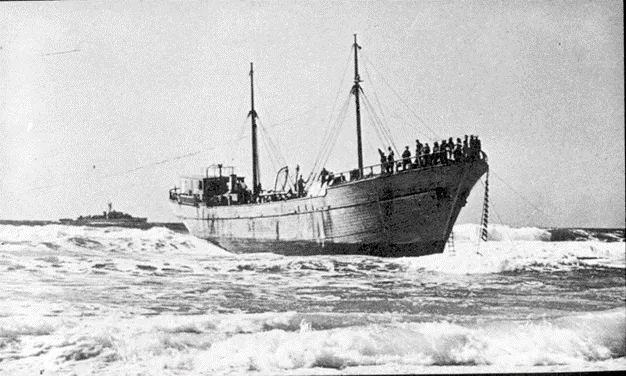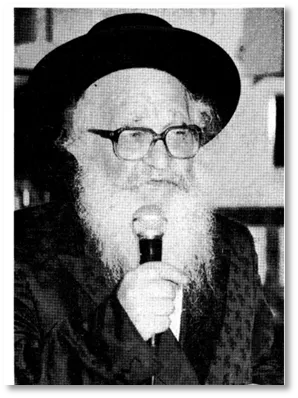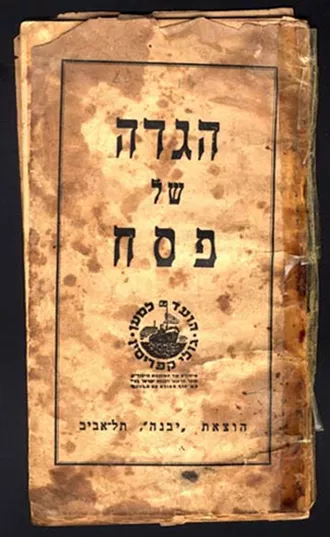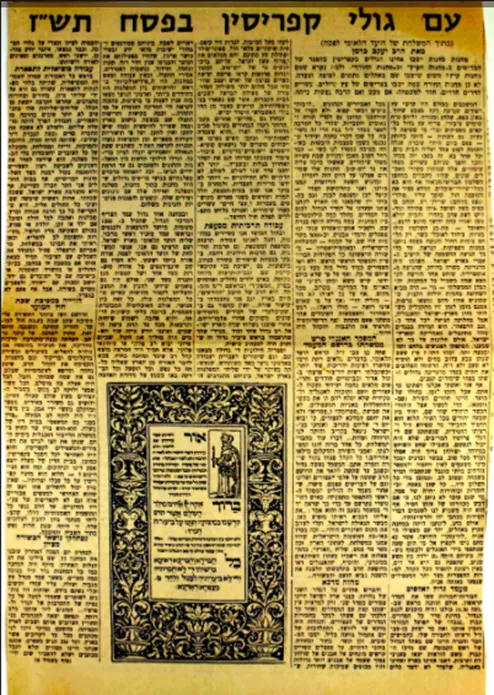To Be Free Men in Exile in Cyprus: Passover in the Detention Camps
“If You had given us the Torah and not allowed us to enter the Land of Israel, it would have been enough for us.”
By: Devorah Surasky
Passover 5707 (1947): From the works of Rabbi Yaakov Bentzion Rotner
“We dealt with Torah lessons and making the kitchens koshers, and in private before Passover we arranged to sell the chametz (leaven) of all the camps…matzahs for the population were sent from the Land of Israel, but for us matzahs with Badatz supervision (a stricter kosher standard) were sent.” (Rabbi Yaakov Bentzion Rotner, “And I Will Tell of the Deeds of G-d”)

The “Shabtai Lozinsky” ship
In the dreams of the illegal immigrants – exilees to Cyprus – they did not imagine that they would celebrate the holiday of freedom on the soil of Cyprus. However, it was the tradition of a people who excelled in choosing that guided the illegal immigrants, and from the descriptions of the time – the Passover holiday was celebrated as usual, with splendor and with the belief “this year we are enslaved – next year we will be free men.”
Passover 5707 (1947) was the first Passover in exile in Cyprus. Those incarcerated in the camps were joined by over 2,000 deportees from the ships “Shabtai Lozinsky” and “Moledet” that had arrived near the holiday’s start.
After the ships anchored in the port of Famagusta, Rabbi Yaakov Bentzion Rotner, from the ship “Shabtai Lozinsky”, and Rabbi Yisrael Noach Brisk, from the ship “Moledet” set foot on the land of the new exile. They did not imagine the meaning of their presence, their influence, and their contribution in shaping Jewish life in this temporary station.
Rabbi Yaakov Bentzion Rotner – later known as “Rabbi from Khalisa” – began his rabbinical career as a rabbi and head of the beit din (religious court) in the exile of Cyprus, and Passover 5702 (1947) he received a premier status in his work. The gray reality of life in the concentration camps broke the spirit of the Jews, and the arrival of the young rabbi showered them with a dew of revival. The rabbi immediately met their needs and the needs of Passover, and the good news of the holiday spread like a pleasant wind.
Preparing for the holiday under the conditions of exile was a challenging task, and one of the first tasks he did, as he testified, was selling the chametz in the camps. Rabbi Yisrael Noach Brisk, who had been the head of the beit din in Miskolc, joined the preparations. “It was a sight to see the older rabbi together with his younger colleague marching with vigor and genius between the camps… The campaign to sell the chametz spread over several days was finally crowned with success…” (H. Kopolovitz , editor: Rabbi Rotner, the Rabbi from Khalisa). [1]

Rabbi Yaakov Bentzion Rotner
Beyond this, Rabbi Rotner took care of making the kitchens kosher: he devotedly traveled between the camps to teach the laws of making vessels kosher using boiling water, and was even involved in specific koshering tasks.
“I remember that night very well. I was not an ‘only son’ in the rabbi’s tent. I don’t know how many guests there were besides me, but they were many” (ibid.).
The highlight was the Seder night itself – a very impressive event that was preserved in the memories of the participants for many years, and was described by Rabbi Michael Daskal:
“… and we arrived in Cyprus a few days before the holiday… and amidst all the enormity of the deportation and the forced acclimatization, I had to figure out where and how I could celebrate Passover according to Jewish law… A man who is like a saving angel, the rabbi z”l, appeared from somewhere and extended his hand to me with Jewish warmth with a ‘Shalom aleichem’ (peace be upon you). I didn’t know who the young Jew, who was so happy to meet me, was… then while talking he offered me to come and sit at his table on Seder night… the poverty and scarcity that hung over the island like an oppressive cloud… but here in the tent we didn’t feel anything except the heartwarming feeling of freedom that emanated from the rabbi’s heart… we too felt as if we had left Egypt that night.” (ibid.).
Even the rabbi did not give up on the custom practiced by the People Israel from long ago – to glorify and decorate the Seder table – and the family members testify that his love “went over the line” – with his hands he labored to create beautiful vessels from tin found in the camps.
The illegal immigrants sat at the Seder table as if it were the table of kings – Cyprus as the entryway to the king’s palace – and in their mouths was the yearning: “…and we will thank you with a new song for our redemption and the redemption of our souls”.
Passover 5707 (1947) with the exilees in Cyprus – a description from the delegation from the Land of Israel: “When the appointed hour arrived, we all got up and I wore the outfit for the Seder – a white Kitel… and we marched to the large Seder.”
Article by Rabbi Yaakov Berman (Education site, the National Library of Israel)
Ahead of Passover, a delegation of the “National Committee” left Israel for the detention camps in Cyprus. Among its members is Rabbi Yaakov Berman, an educator and leader of the Mizrachi movement. In the included article, which can be found in the National Library, his impressions of the journey and his stay during Passover with the inmates of the camps are described. His description reflects a bleak picture of life and of a harsh daily reality in the camps: “The beds were all wooden planks covered with a thin black blanket… even drinking – was in short supply – once a day a cart pulled by one horse with a barrel of water would pass by, and everyone came with his own container and bag… and the food – the whole government had problems… especially for those who kept kosher, only for the bread on weekdays and matzah on Passover were they were given in sufficient portions.” On the other hand, his admiration for the long-suffering of the detainees is evident: “However, we have not heard any complaints about this. The humble were satisfied with bread and tea, and matzah and tea. And what is the tea? A kind of herb that gave a yellow colour to the water and added neither taste nor smell…”
Regarding the Seder, he writes that in the first stage it was held “in groups”, and later, in a central gathering: “in a group of all seders”. And this is how he describes the Seder in the group he participated in: “Our brothers in Israel and our brothers in England made sure that nothing was missing from the seder, from all the accompanying accessories, including eggs and frozen meat, and of course there was no shortage of Torah words and speeches and explanations on our table either, because everyone who recites the Seder on the night of Passover, is praiseworthy”.
Many from several camps gathered at the “Seder of all the seders,” and they entered into a “huge amphitheater with benches and stone floors, and about 5,000 seats were there.” He describes the second Seder for holdiays taking place in exile as a “depressing spectacle” in which the exilees lamented their presence in exile instead of in Jerusalem: “The spectacle was depressing to the point of horror. Yesterday’s enthusiasm died completely… they sat twisted… the candles were tin cans full of sand… and they filled the barrack with smoke and fog. The women recited blessings over the holiday candles… they recited the Exodus chapter in a tone of despair and sadness…” An atmosphere of spiritual turmoil did not escape the detention camps, as he describes: “In the synagogues, there were Torah lessons as is customary in the Diaspora… and there is no shortage of ‘Stieblach’ (small synagogues) of chassidim from different chassidic sects…”
“All Who are Hungry”: Organization, Assistance and Support from the Land of Israel, the Joint, and the Jewish World

A Passover Hagada published by the Committee for Exilees in Cyprus
“The Committee for Exilees in Cyprus” – this is how the Hagada was signed in the picture in front of you. This Hagada is an example and an expression of the enterprise of the Jewish settlement in the Land of Israel that supported and helped the prisoners in the detention camps in Cyprus. The “Committee for Exilees in Cyprus” – a central body in activity with large circles of influence – was established by the Jewish Agency for Palestine along with the National Committee and the Joint. The committee collected donations, food parcels, and clothing, and held special operations such as “winter covers” – collecting clothing for the winter of 5708 (1948), and fundraising operations before holidays. This Hagada was sent before Passover 5707 (1947) to the exilees in Cyprus by the “Committee for Exilees in Cyprus.”
Beyond the actions until now, various packages and support were sent to the exilees in Cyprus, and emissaries from the entire Jewish world even came to visit them.
Along with all the global initiatives, the local initiatives occupy an important and significant place – of the inmates of the camps themselves, of rabbis (as detailed above), of committees and bodies that were established independently to organize Jewish life throughout the year, and to keep the holidays according to Jewish law.
The religious committee that operated in the camps began to organize in preparation for the Passover holiday of 5707 (1947), which was the first to be celebrated on Cyprus. The committee conversation with the camp authorities to guarantee kosher food for the holiday, and even took care of koshering vessels with boiling water.[2] “Among other things, the committee arranged a special time for immersion in the sea (instead of a mikveh, a ritual bath)… even announced that all those who are knowledgeable in the laws of koshering vessels with boiling water should contact Rabbi Goldfinger to perform the koshering for the entire population” (M. Weinstein, “Religious Zionism on the Margins of the Land of Israel”).
Food shipments were sent from pre-state Israel at the request of the Joint and the Committee for Exilees in Cyprus, which was a major partner in taking care of the physical needs of the camp exilees. The cargoes arrived only in the late afternoon on the eve of the holiday. “…Large quantities of carp and matzah, wine, etc., which were loaded on the ship that was supposed to arrive at the port of Famagusta on the eve of the holiday at eight o’clock in the morning, but due to the weather conditions the ship arrived only at two o’clock in the afternoon. The British authorities assisted in the rapid transfer of the food for Passover, and in loading it onto ten trucks for the purpose of distributing it in the camps before the holiday, so that the fish could be cooked before the start of the holiday, the first day of which fell on Shabbat (when cooking is prohibitted).” (ibid.).
While the Cyprus exile continued and the Holiday of Freedom of 5708 (1948), the second in the history of this exile, arrived for the prisoners, the organization began to become more intense. According to the data, most of the imprisoned wished to avoid eating chametz and ensuring that the food was kosher required special organization. “About a month before Passover 5708 (1948)… there was a coordination meeting of all the parties. At the meeting, they looked at how it would be possible to provide food for Passover for a population of about 25,000 illegal immigrants, when the stock of food and fruits and vegetables that could be obtained in Cyprus was limited. The British announced that they would try to keep for a short period (about two months)… stocks of potatoes, vegetable oil, and fresh fruit. It was estimated that it would be necessary to import about one hundred tons of matzah, which would be purchased by the Joint.” (ibid.)
Various problems arose during the preparations for the holiday, such as the oil issue: “The British only provided peanut oil, but the people who kept kosher do not use it on Passover, the alternative could have been olive oil, which was expensive. Therefore, it was agreed that the oil issue would be decided after consultation with the military rabbi” (ibid.). A proposal was even made to provide potatoes instead of the macaroon quota, and if the idea did not come to fruition – the flour quota would be distributed before or after the holiday. The British agreed to the requests.
When vast numbers of the Jewish People raised a second glass of wine on the Seder night and announced all over the world that, “We have come out of slavery to freedom… and from darkness to great light, and from slavery to redemption…”, the freed men in Cyprus joined together in the Jewish song: “Redeemed, to Zion in joy.”
[1] On the activities of Rabbi Rotner, see: H. Kopolovitz, editor: Rabbi Rotner, The Rabbi from Khalisa: The Life Story Enshrined in Holiness of the Genius & Righteous Rabbi Yaakov Bentzion Rotner. The activity of the rabbi described above is just a few of his many works, which included: building Jewish homes, marriages, releases women who did not know the fate of their husbands from marriage, educational and Torah establishments, fortifying the walls of religion, kindness, etc. Thanks to the family members and the Rabbi from Khalisa Institute for the help with information about him and life in Cyprus.
[2] On religious life in Cyprus, see: M. Weinstein, “Religious Zionism on the Margins of the Land of Israel”: The ‘Torah and Avoda’ (Torah and Work) Movement in the Cyprus Detention Camps. In chapter 3 – Religious life in the Cyprus detention camps.













